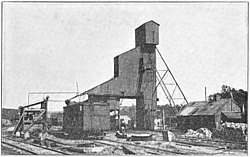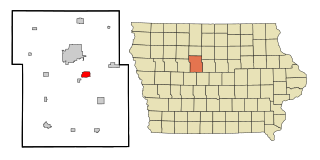Buxton
As early as 1888, a few small mines were in operation along Bluff Creek, but this changed at the dawn of the 20th century. In 1900 and 1901, after extending the Muchakinock branch of the Chicago and North Western tracks across the Des Moines River, the Consolidation Coal Company opened a new mining camp at Buxton, in Monroe County [25] 41°9′30″N92°49′15.63″W / 41.15833°N 92.8210083°W . The camp was named by B. C. Buxton after his father, John E. Buxton, [26] who had managed the mines at Muchakinock. The company created a planned community that was developed along a regular grid pattern. It hired architect Frank E. Wetherell to design miners' houses, two churches, and a high school as part of its "urban planning and social humanitarianism." [27] The US Post Office at Buxton operated from 1901 to 1923. [28]
Many black workers moved here from Muchakinock. After a strike by white miners, the company recruited additional black workers from mining areas in the South. The town's population was multi-ethnic, with white immigrants from Slovakia, Sweden, Austria, Ireland, Wales and England. [1]

Consolidation Mine No. 10 was about 2 miles (3.2 km) south of Buxton, with a 119-foot-deep (36 m) shaft and a 69-foot (21 m) headframe, working a coal seam that varied from 4 to 7 feet (2.1 m) thick. The hoists could lift 4 cars to the surface in a minute, each carrying up to 1.5 tons of coal. Electric haulage was used in the mines, using a combination of third-rail, trolley wire, and rack-and-pinion haulage. Mine No. 11, opened in 1902, was about a mile south of No. 10, with a 207-foot (63 m) shaft. By 1908, Consolidation had opened Mine No. 15. All of the Buxton mines worked a coal seam about 54 inches thick.
In 1901, Consolidation's miners organized locals 1799 and 2106 of the United Mine Workers union, with memberships of 493 and 691, respectively. Local 2106 immediately became the largest union local in Iowa, in any trade. [29] At that time, Consolidation's mines were described as being "worked almost entirely by colored miners." [30]
In 1913, the Buxton UMWA union local was reported to have "at least 80 percent colored men". [4] With 1508 members, Local 1799 at Buxton was the largest UMWA local in the country. [31] African Americans continued operating the benevolent society they had established at Muchakinock, renaming it as the Buxton Mining Colony. [32]
Buxton was a classic company town; it was unincorporated, and the CCC was the sole landlord. In the words of one commentator, "Mr. Buxton ... has not attempted to build up a democracy. On the contrary he has built up an autocracy and he is the autocrat, albeit a benevolent one." [32] Booker T. Washington, educator and president of Tuskegee Institute in Alabama, described justice in Buxton as being "administered in a rather summary frontier fashion" that reminded him "of the methods formerly employed in some of the frontier towns farther west." [33]
The Consolidation Coal Company took a paternal attitude toward the town. In 1908, the town covered approximately one square mile, with about 1000 houses, typically with 5 or 6 rooms each. Everything was owned by the coal company. It provided rental housing only to married couples, at a rate of $5.50 to $6.50 per month. Families having any kind of disorder were evicted on 5 days' notice. The average wage in the mines was $3.63 per day in 1908 (~$123.00 in 2023), when the mines employed 1239 men. Monthly wages varied from $70.80 for day laborers, but about 100 men made more than $140 per month. [32] There was no discrimination between the races in pay.
As in Muchakinock, African Americans held many leadership roles in the integrated town. The US postmaster, superintendent of schools, most of the teachers, two justices of the peace, two constables, and two deputy sheriffs were all African American. The Bank of Buxton, with deposits in 1907 of $106,796.38, had only one cashier, also African American. One of the civil engineers working for the mining company was African American. [32] [33] For a brief time between 1903 and 1905, The Buxton Eagle was the community's newspaper. [34] African-American physicians included Edward A. Carter, MD, who was born in Muchakinock and was the first "colored" graduate of the University of Iowa College of Medicine. He came to Buxton as assistant physician to the Buxton Mining Colony. He also served as company surgeon to the mining company and to the Chicago and Northwestern Railway. [35] [36] George H. Woodson and Samuel Joe Brown were African-American attorneys who lived in Buxton for a time; they were among the co-founders in 1905 of the Niagara Movement, a predecessor to the National Association for the Advancement of Colored People (NAACP). [2]
Richard R. Wright Jr. wrote in 1908 that
The relations of the white minority to the black majority are most cordial. No case of assault by a black man on a white woman has ever been heard of in Buxton. Both races go to school together; both work in the same mines, clerk in the same stores, and live side by side." [32]
In the same year, Booker T. Washington wrote of Buxton as "a colony of some four or five thousand Colored people ... to a large extent, a self-governing colony, but it is a success." He recommended a study of Buxton to a textile manufacturer interested in raising capital for a cotton mill employing black labor. [37]
By 1908, as mines 11 and 13 were almost exhausted, the population of Buxton had declined to about 5000. It was still the largest town in the country with a majority-black population. In addition, it was the "largest unincorporated city in the nation and the largest coal town west of the Mississippi River." [2] Unlike smaller company towns, where miners usually lived within walking distance of the mines, Buxton was the residential center for men who worked at mines spread out over a considerable distance. The company ran commuter trains to ferry the men to the mines.

The coal company gave the YMCA free use of a building, valued at $20,000. [38] The YMCA had a reading room and library, gym, baths, kitchen, dining room, and a meeting hall available for use of labor unions and lodges. [39] The Buxton YMCA drew "the color line" and did "not allow white men in the membership," although they were "allowed to attend the entertainments, a privilege freely used." [40] The Buxton YMCA offered a variety of adult education programs, including literacy and hygiene classes, as well as a variety of public lectures. The YMCA also controlled the Opera House, keeping out "objectionable and immoral shows." [41]
As is typical of mining company towns, there was a company store, the Monroe Mercantile Company. This was a big operation, with 72 employees, some paid as much as $68 per month, and many of them African Americans. But there was competition for the company store. Buxton was unusual for its more than 40 independent businesses that operated in town, including a hotel, grocery, general store, meat market, lumber yard, barber shops, tailor and butcher, and clothing stores. [2] Many were run by African Americans. [32]

In 1919, Consolidation Mine No. 18, 12 miles southwest of Buxton ( 41°3′26.21″N93°0′43.23″W / 41.0572806°N 93.0120083°W [42] ), was the most productive coal mine in Iowa. This mine employed 498 men year round, producing almost 300,000 tons in that year, which was more than 5% of the total production for the state. [43] Mines 16 and 18 exploited a coal seam 4 to 7 feet thick. [44] But after World War I, the demand for Buxton coal declined. Competitive coal was being marketed by overseas locations. The remains of Mine No. 18 were dynamited in 1944. [45]
By the time Mine No. 18 had opened, the center of CCC mining activity had moved 10 miles to the west of Buxton, and the company opened new mining camps closer to the mines. As a result, the population shifted and Buxton declined markedly in the 1920s; its last mine closed in 1927. [2] By 1938, the Federal Writers Project Guide to Iowa reported that the site of Buxton was abandoned and that the locations of Buxton's former "stores, churches and schoolhouses are marked only by stakes." Every September, hundreds of former Buxton residents met for a reunion on the site of the former town. [46]
The abandoned Buxton town land has been cultivated as farmland. The town site was the subject of an archaeological survey in the 1980s, which investigated the economic and social aspects of material culture of African Americans in Iowa. [47] As a result of the finds and the regional and national significance of Buxton, the archeological site was listed on the National Register of Historic Places. The company town is notable as a former "black utopia." [2]










